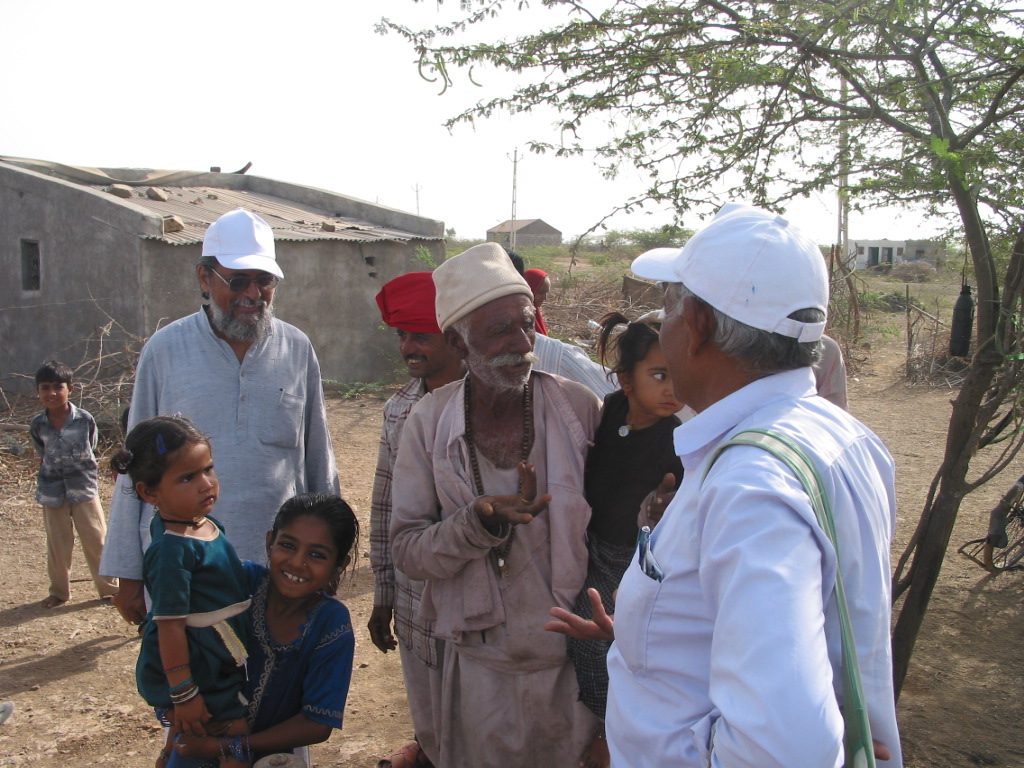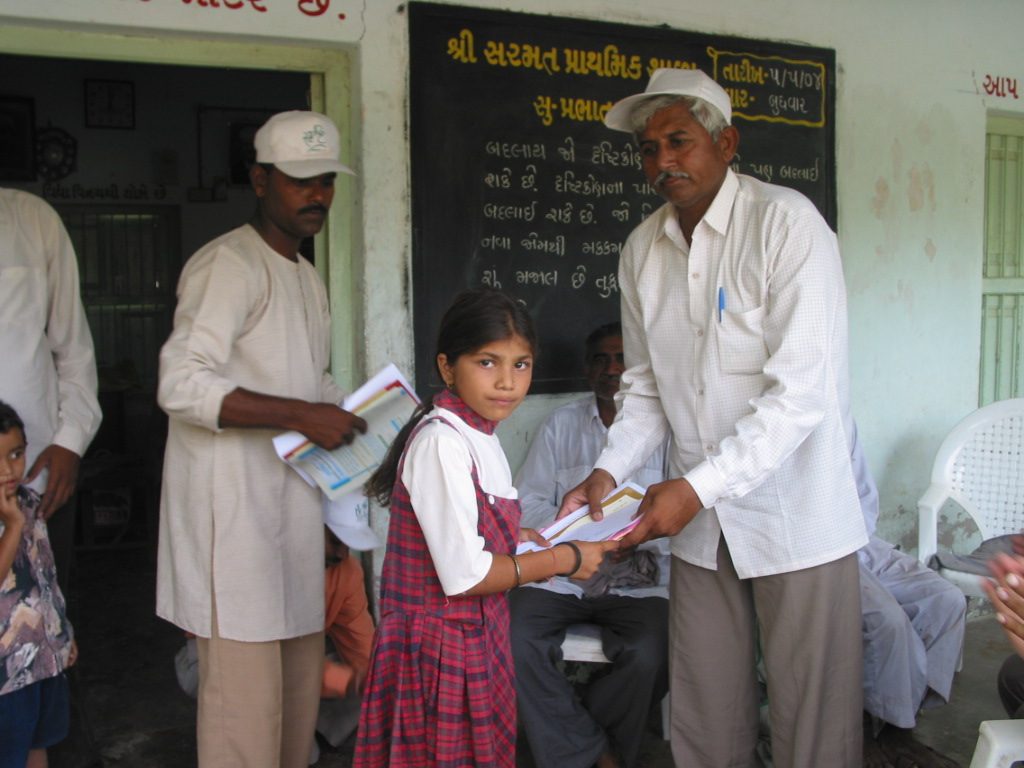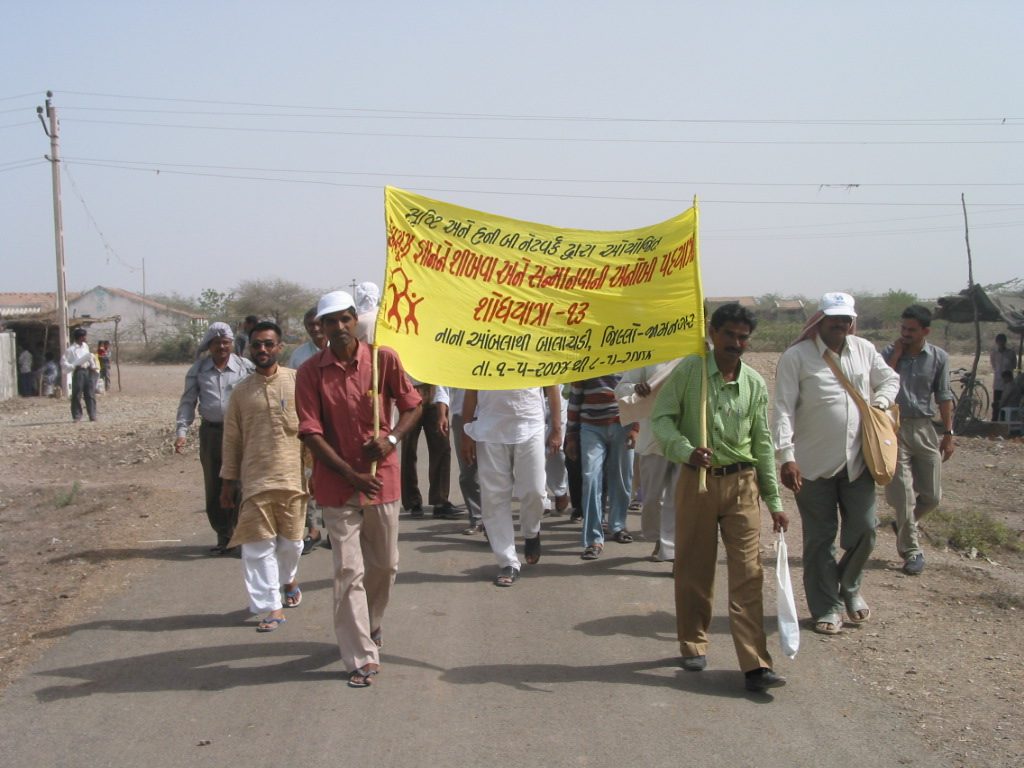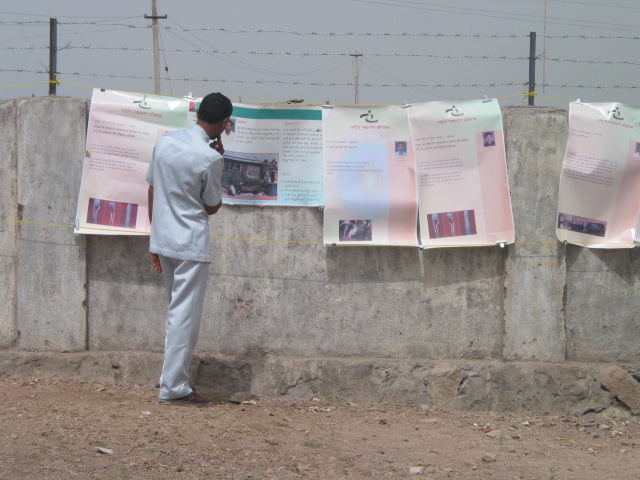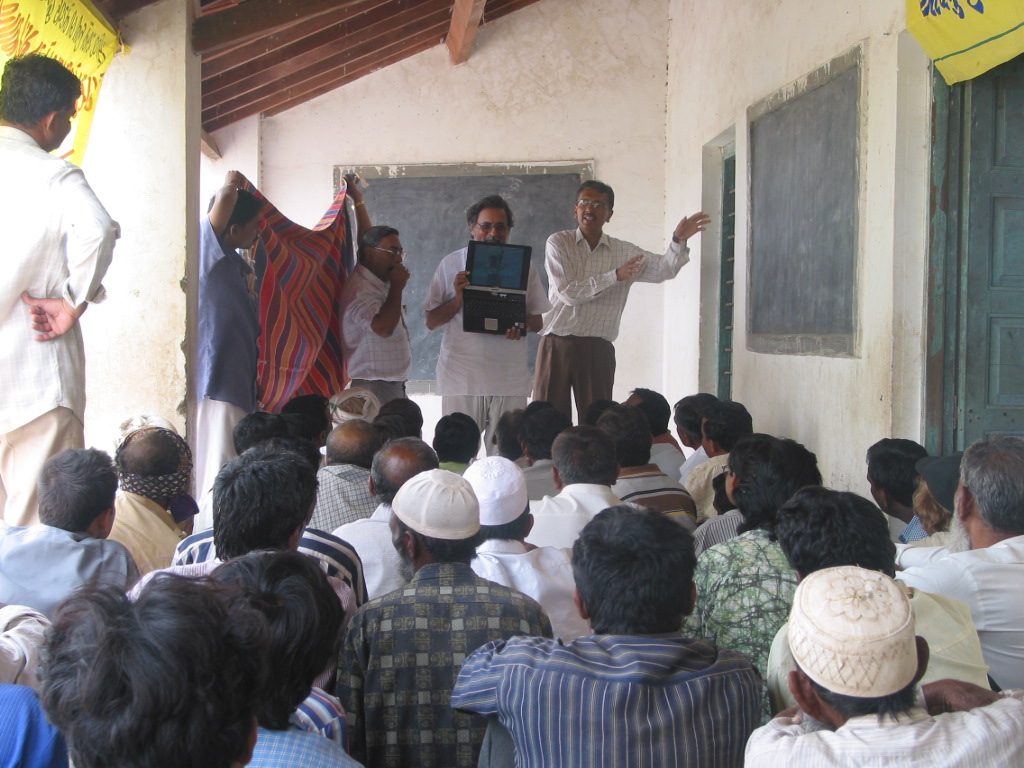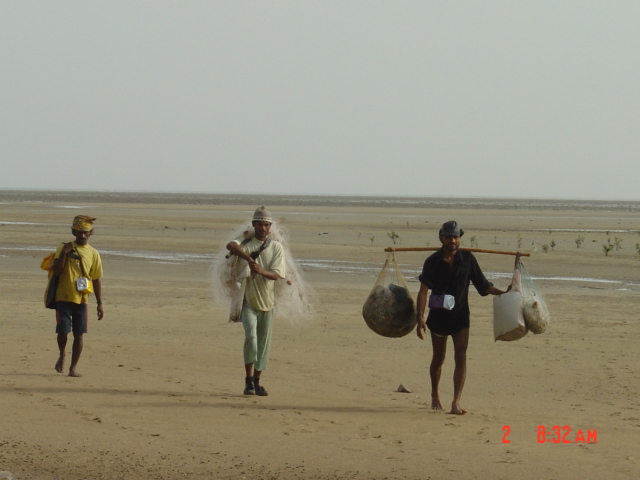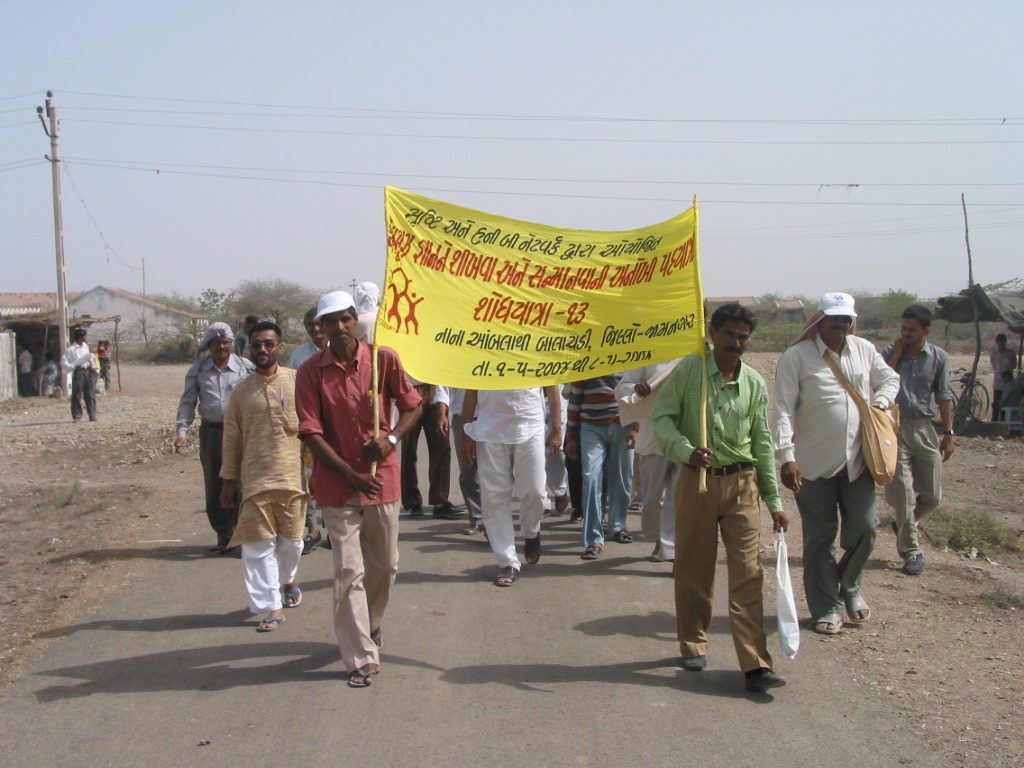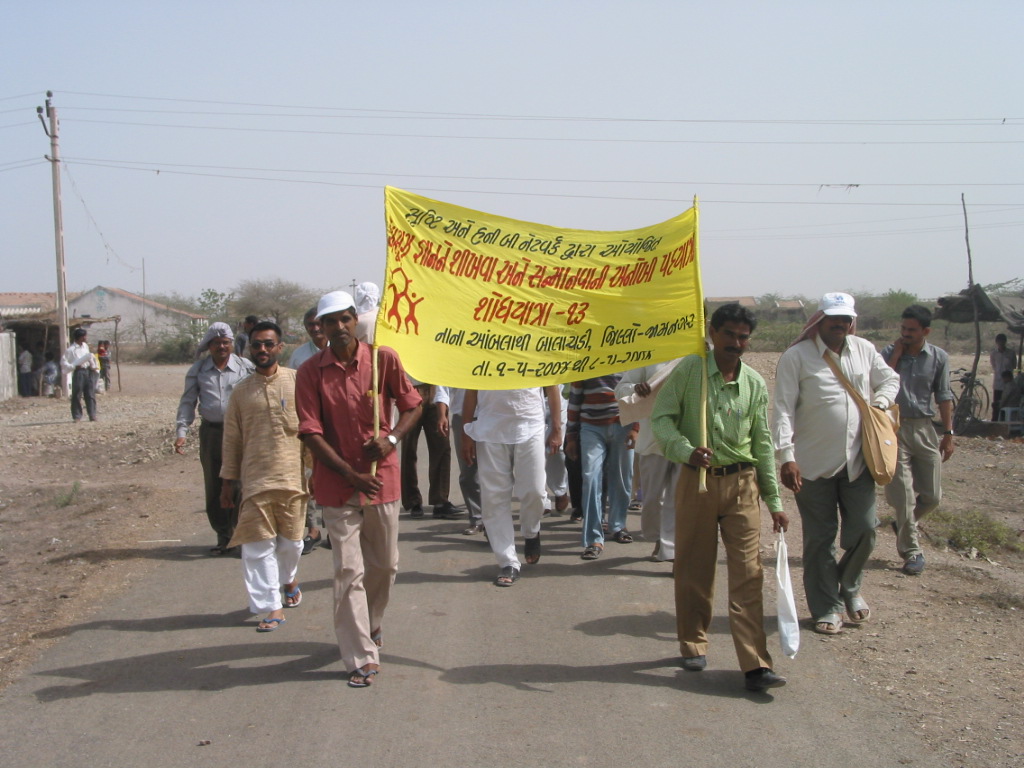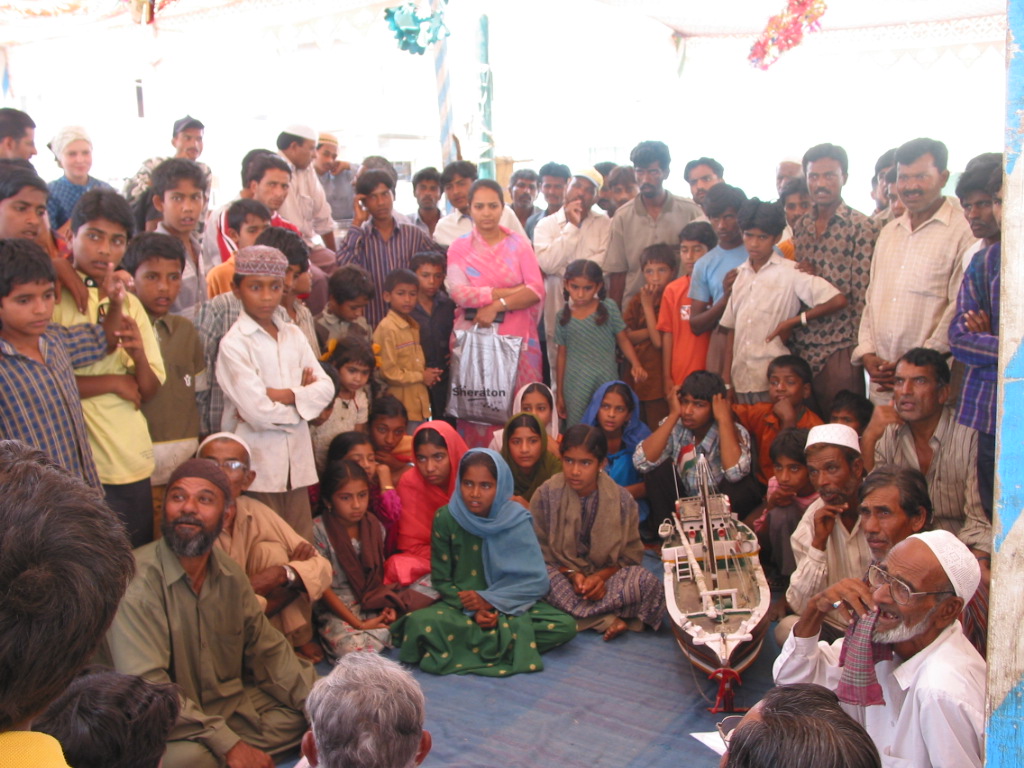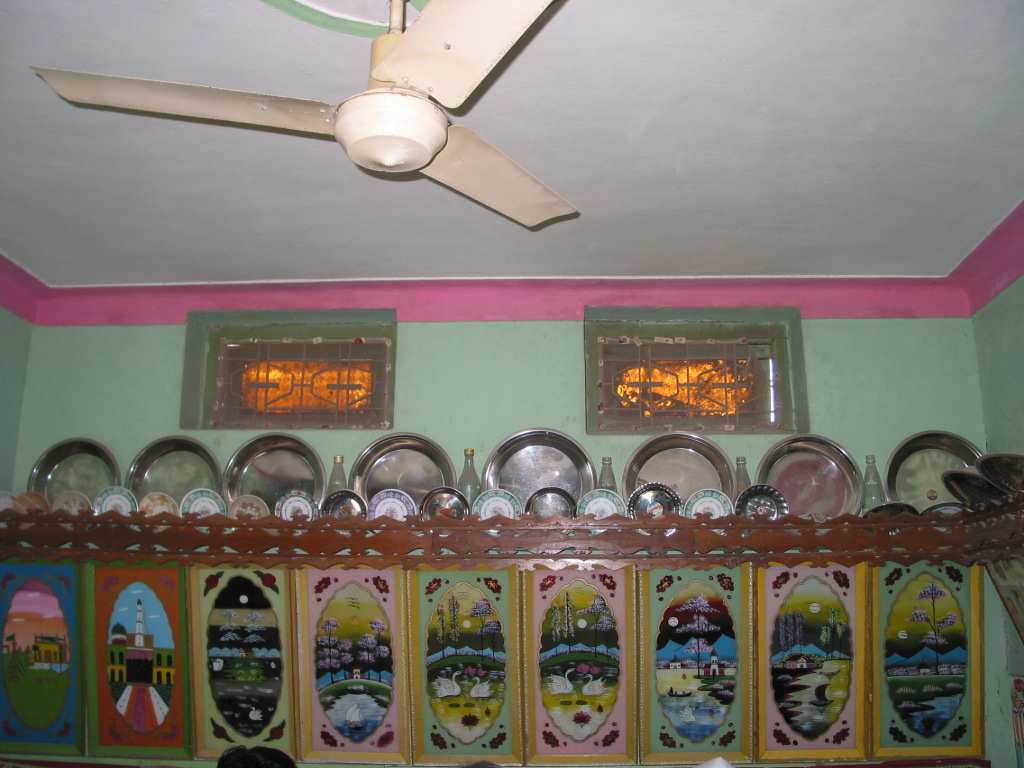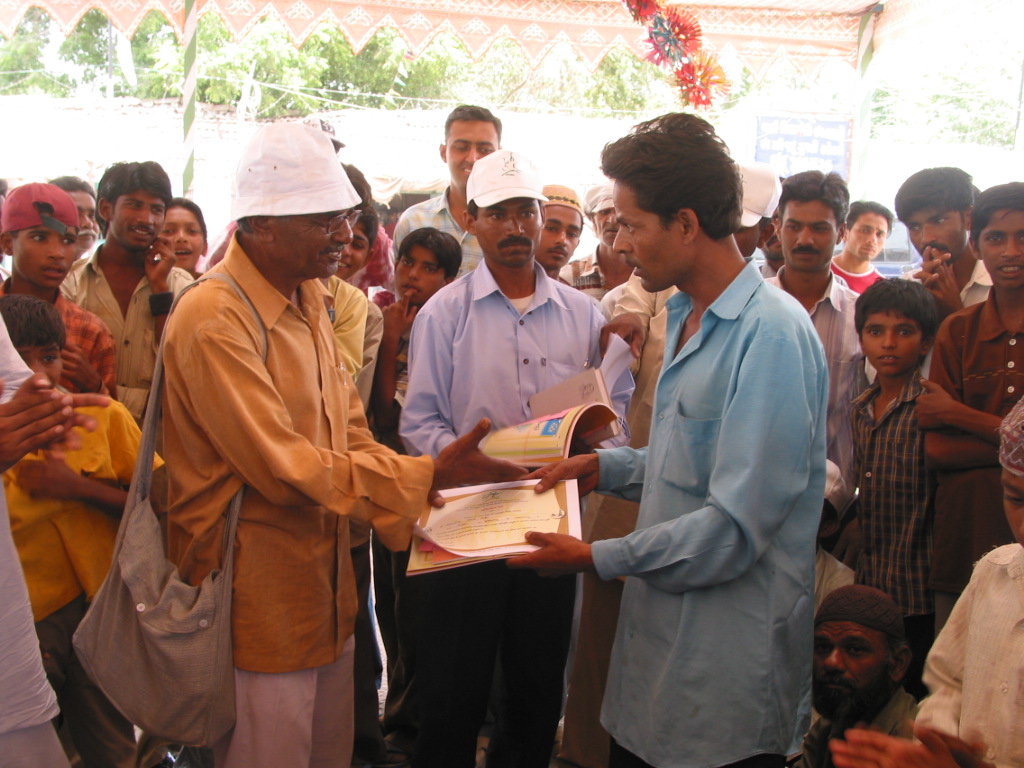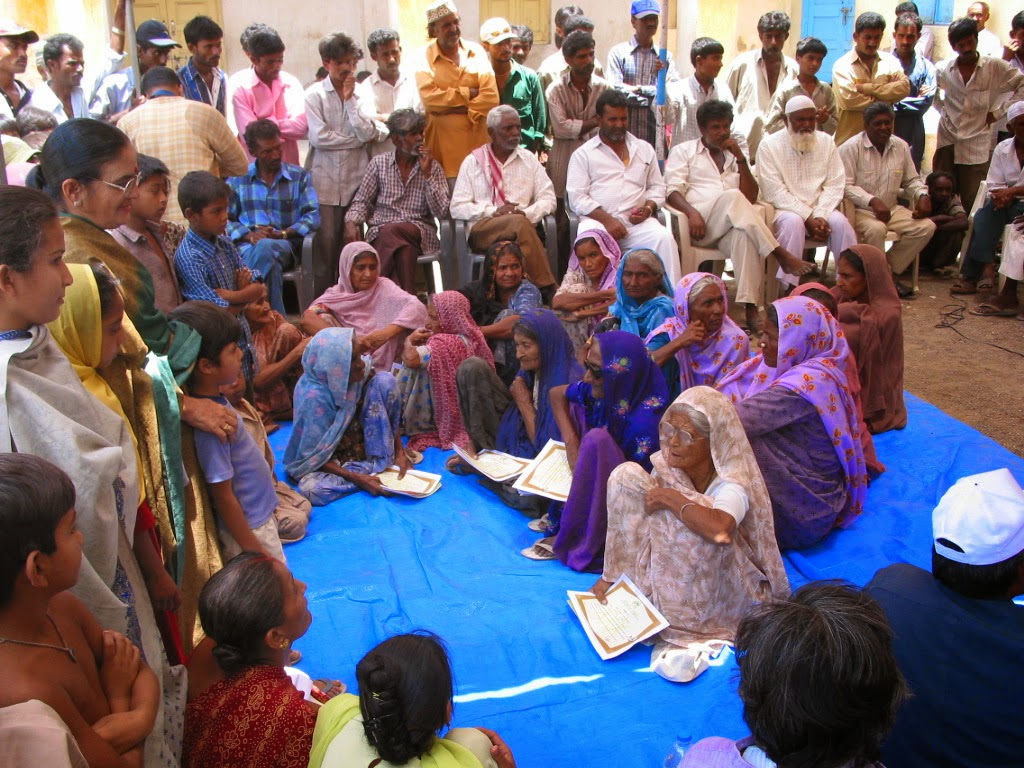Get Next Shodhyatra Update:
Phone:
079-27913293, 27912792
Email:
shodhyatra@sristi.org
13TH SHODHYATRA, NANA AMBALA TO BALACHADI (GUJARAT)
The 13th shodhyatra held from May 1-8, 2004, covered a distance of 150 km in Gujarat. 40 Shodhyatris travelled from Nana Ambla to Balachadi, a route that constantly kept them close to the seashore. In fact, this was the first time that the Shodhyatra was taking place close to the sea. In all 17 villages were visited covering a distance of 150 kms. A total of 14 veterinary healers, six fishermen and 24 centurion women were felicitated. 1100 children in nine schools participated in biodiversity contests and 34 students, including 16 girls, won prizes in various contests.
The objectives of the Shodhyatra remained the same as before: documenting traditional local knowledge and felicitating knowledge holders with special focus on women centurions who are a unique resource and to encourage children to be concerned about biodiversity. This was done primarily in the form of involving children in biodiversity contests that were held in different villages.
Day 1
The first day of the Shodhyatra began with an opening ceremony at Nana Ambla village. The yatra’s objectives and the work of the Honey Bee Network were explained. It was stressed that the Shodhyatra was different from religious and political yatras. Here, the objective was to make society innovative and progressive.
Ismailbhai Ibrahimbhai Gajan, a local veterinary healer (pashu vaidya) was felicitated. He said that he used local herbs in his treatments. Ismailbhai, who was more than 100 years old, bemoaned the extinction of many herbal plant species. This was affecting treatment procedures.
He also said that drinking water was a serious problem in the village.
The centrality of water in their lives was stressed by Jumabhai Ahmedbhai Gajan. He said that if it the monsoon is good, they do farming. But when monsoons fail, the villagers turn to fishing for their livelihood. The ocean becomes our lifeline, he said. After lunch and a brief rest, Shodhyatris left for the next village.
The next halt was Bharana. At seven pm, a meeting was organized there. Children from the village welcomed the Shodhyatris with songs. Students who had won the biodiversity contest held earlier, teachers and the village sarpanch were felicitated. Bharana village also provided the first woman centurion of the Shodhyatra, Jivaben Naranbhai Chavada, who was felicitated.
Innovations were highlighted and presented through a demonstration of the multimedia database.
Day 2
On day two, the Shodhyatris left Bharana at 5.30 am in the morning for Narara beth (Narara island), renowned for its unique flora and fauna. Forest Department officials were present and they shared information about the island.
We were shown the giant sea animal (Stichodactyla gigantea) which lives in shallow waters. It looked like a big, green flower and was, in fact, known as sea flower in this region. The island was also famous for its coral formations present in different and vivid colours. However, increasing pollution had begun to affect the coral and also the octopuses found in this region. Dead coral which take on a grayish tinge were becoming a common sight.
But there was something to cheer about. Cher (Avicennia marina) tree which had once been present in abundance and had over the years become rare, was making a comeback. Forest officer M N Joshi spoke about the novel afforestation attempt. This method involved placing seeds of cher in pots. The pots were filled with the soil brought to the surface by gulla, an animal that makes tunnels in the ground. The pots were placed on the shore itself where they could be easily reached by the waves. The seeds thus received the salty water of the sea which was beneficial for their growth. As the plant grew, its roots would break the pot. The plant would then continue to grow with its roots going deeper into the soil. This method had been used for the first time three years ago and had proved to be very effective.
Shodhyatris were also shown foker fish locally known as phako or dhongi. This fish had poisonous teeth. It was considered a delicacy in China and Japan.
After a refreshing lunch at the island, the Shodhyatris made their way through salt farms to the next village. Proximity to the sea made salt making units a common sight in this region. One would often come across bunds where the sea water was trapped to provide salt which would be collected and stored in huge piles on the shore. In many places, pumps had been installed. These could draw water deeper into the shore. However, the increased presence of salty water on the shores and inland areas had compounded the problem of brackish water in this region.
Later, the Shodhyatris reached Singach village. A meeting was held in the night. Shodhyatris Pathubhai Rathod, Vallabhbhai Bhuttani and Jamnagar Sajiv Kheti Mandal, Nileshbhai Dave spoke about their experiences and experiments related to organic farming. A demonstration of the multimedia database followed. Veterinary and human healers were felicitated.
Here, we met our second centurion woman. Her name was Deviben Bhimabhai Lakum. We went to her house. She told us a lot about first aid and treatments for animal disorders and diseases. She also spoke about her own times.
Day 3
On the morning of day three of the yatra, we left for Jakhar village. Here, a meeting had been organized in the primary school. We met two centurion women who were felicitated. There was a discussion on organic farming. Multimedia presentation was also made. There was great interest in one particular innovation – that of the cycle that could be used in water.
After the meeting, we left for Gagawa village. Here, we met a veterinary healer Khimabhai Jeevabhai Rathod. He spoke about the harmful effect of plastic on cattle. He said that the use and production of plastic should be stopped. Shodhyatris felt that something could be done only if everybody came together and raised their voice.
Three farmers in the village showed us a new variety of wheat called puttariya.
This variety could grow in hard black soil. The wheat grain spike (umbi) had a somewhat rectangular shape.
Its nutritional value was said to be high. The farmers said that pests did not attack the grains if they were stored along with the husk. However, separating the grain from the husk required much effort and that was why this variety was not very popular.
The next destination was Mungani village. During the meeting held in this village, biodiversity competition winners were awarded certificates. Multimedia presentation was made. Veterinary healer Ismailbhai Wajabhai was felicitated. He shared some of his treatments. For goats that suffer from bloat, he said that he mixes butter, salt and ash in equal quantities. The root of the banyan tree is taken and one of its ends pounded. This is used as a brush. It is dipped in the mixture which is rubbed on the mouth of the cattle.
Day 4
In the morning of day four, Shodhyatris set out for the next village Sikka. The 30,000 strong population of this village speak Vaghad (Kutchi) language. They also speak Gujarati and Hindi. A meeting was held in the village.
However, the highlight of the visit to the village was the interaction with three centurions who were members of one family. Ayubbhai Hussainbhai Kungada was 102 years old while his sister Alima Ayubbhai Kakkar was 107 years old. His wife Haajiyani Ayesha Ayub Kungada was 102 years old. Ayubbhai had been a fisherman. He had also been involved in the business of exporting coal and other commodities. Ayubbhai, his wife and sister were felicitated in their house.
Ayubbhai mentioned that earlier they used to fish for gadhari and amrus. These fishes weighed about 20-30 kgs. However, they had now become almost extinct. He himself had stopped fishing thirty years back. His son was a government employee. No one in the family now worked as a fisherman.
We also met Ahmedbhai Gandar, an expert in making boats. He mentioned that saag (Tectona grandis) and baval (Acacia nilotica) were used in making boats. Oil from the siya fish was applied on the wood to make it stronger. The villagers shared the problems that they faced.
After lunch and a brief rest, Shodhyatris left for Bed village. On the way, we were joined by Angelina Withrona Framovitch who had come from Russia. She said that Russian farmers were also moving towards organic farming.
There was a memorable welcome awaiting us at Bed village. Villagers played dhol, nagadhe and shehnai (all musical instruments). Small girls, dressed in their traditional finery ushered the Shodhyatris into the village.
At the meeting, veterinary healers Bhagwanbhai Damajibhai Kanjadia and Devabhai Karsanbhai Katesia were felicitated. They spoke about healing animal ailments. 98 students had participated in the Biodiversity competition that had been held earlier in the village. The winner, Kishorebhai Gordhanbhai Songara of class IX, could identify 190 plants and their uses.
Sarmat villages Bahadurbhai was present at the meeting. He spoke about the need for check dams so that rainwater that flows off into the sea could be utilized in farming
Shodhyatris went to Devasibhai Hajjanbhai Nevarabhai Rabaris house who had ten camels. He shared information about camel rearing.
At the next halt, Rasalpura village,
fishermen spoke about common and rare fishes. They mentioned that
dantiya (or dantaro, Psettodes erumei) and kunga (Scombridaespp)
could still be found in good quantity. However, fala, bhar and
chacharani had become rare.
These are difficult times for the local communities residing in the coastal areas of Gujarat. Not only do they have to deal with the age old vagaries of nature, but also with man-made problems.
- A large industrial house with a sizeable presence in the region would tear their nets whenever it felt they were fishing in the part of the sea on which it claimed property rights. No skill up gradation or alternative employment opportunities were provided to the local communities by the industrial house. In fact, unemployment was a common problem in most villages.
Decline in the number of fishes both in terms of variety and catch had affected their livelihood. Water pollution was stated as the main reason for the decline. - Sometimes because of strong winds, the fishermen inadvertently strayed into Pakistani waters. The fishermen felt that the Indian and the Pakistani government should look at such cases differently and resolve them in a co-operative manner.
The government gave loans and subsidies to farmers. Such facilities were not provided to fishermen and others who depend on the sea for their livelihood. - The fishermen had to pay fees for visiting Pirotan, a pilgrimage spot. They felt that they should be exempted from this fee.
Once the fishermen ventured out into the sea, there was no way of communicating with the people on shore as the use of mobile phones was banned. - Proximity to the salty water of the sea had made the groundwater brackish. Deep drilling had caused sea water to ingress and this had affected water in the wells. Drinking water had become a major problem.
- Brackish water had affected the fertility of the soil and productivity had gone down
- The workers in the salt farm usually developed ulcers and warts on their legs, suffered from heat stroke and skin problems. Sunlight reflected off the salt crystals could even cause blindness.
Day 5
Onday five in the village Sarmat, the meeting had been organized in the primary school. Winners of the biodiversity competition were awarded. Veterinary healer Heerabhai Muljibhai Bhanbhi was felicitated. He belonged to a lower caste. He had been taught by a Rajput. It was unusual for a high caste Rajput to have groomed a lower caste disciple.
After the meeting, we went to Alibhai Abhavanis farm. He had developed Resham Patto, a new variety of chilli. He had earlier won a consolation prize in the Second National Grassroots Technological Innovations and Traditional Knowledge Award organized by National Innovation Foundation in 2002.
Alibhai had arranged for lunch. He distributed seeds of Resham Patto to everyone.
Our next destination was Khara Beraza village. On the way to the village, we saw a check dam. Bahadurbhai (son of Alibhai) who was accompanying us mentioned that five to six villages had benefited from the check dam. Shodhyatris had the opportunity of watching the sunset from this point. It was a beautiful sight.
We reached Khara Beraza by 8.30 pm. Since there was a training center for fighter planes nearby, the planes were flying quite low. The noise caused a lot of disturbance in the meeting that had been arranged in the village.
Day 6
On day six of the yatra, Shodhyatris felicitated centurion woman, Lakshmiben Lakhabhai Makwana of Khara Beraza at her house. She was overwhelmed.
We left for Bedi village. The sarpanch of Bedi village, Ameenaben Chamaria, was an impressive woman. We had a discussion with fishermen. They spoke about their problems. In this village, we met five centurion women. They were felicitated in the presence of the villagers. This was a memorable moment. After lunch and a brief rest at Bedi village, we left for Nava Nagana. Two people from Bedi village came with us to show us the way.
At Nava Nagana, there was a meeting at eight pm. Premjibhai Sahujibhai Rathod of this village had developed a plough which uses one bull. This plough could be used for other purposes also.
The plough was demonstrated at the meeting. The villagers had not known about this. Students (winners of biodiversity competition) and innovator Premjibhai were felicitated.
Shodhyatris were asked if they could suggest any method for repelling nilgais (blue bull). Ramesh Patel of SRISTI said that a solution made from nilgai’s dung could be sprayed on the margins of the fields. Alternately, pots filled with buttermilk (10-12 days old) could be placed at some interval in the fields. In both cases, the smell might repel the nilgai, as reported by readers of Loksarvani from north Gujarat.
Day 7
On the morning of day seven, we went to centurion woman Ladhiben Ambabai Katesiya’s house and felicitated her. Then we left for Khijadiya. We walked for eight kms through a bird sanctuary. The sanctuary was famous for migratory birds but these came only in the winter season.
In Khijadiya village, we held a meeting. We were told that the villages farming potential was limited – it had salty water. Most of the young men had gone to nearby towns for work.
After lunch and a brief rest, we left for Sanchana village. On the way, we saw light pink flamingoes in large numbers. It was a beautiful sight.
By 6.30 pm, we had reached Sanchana village. Initially, villagers did not come for the meeting. But once the projector was set up, people started trickling in.
Most of the people in the village, it was learnt, were involved in the work of dismantling ships.
There was an in-depth discussion on the Shodhyatra after dinner. The benefits and drawbacks, arrangements and the obstacles all these issues were discussed. It was also felt that there was need to focus particularly on innovators and centurion women and how they could be encouraged. Jamnagar Sajiv Kheti Mandal’s workers (the organization had played an important role in organizing the Shodhyatra) were very enthusiastic and happy. They said that while the Shodhyatra would end tomorrow, they would draw from their experiences and the discussions and their Shodhyatra would continue.
Day 8
In the morning of day eight, we left for Balachadi. On the way, we had the opportunity to see how ships are dismantled. A tea stall owner requested us to have tea at his stall. He had read about the Shodhyatra in the local newspaper. He refused to take money from us. We were overwhelmed by his regard.
In Balachadi village, we felicitated a centurion woman Noorbai Ismailsha Shamdar Fakir. She spoke about her life. She also shared many practical tips, remedies and treatments that she had learned from her elders.
The closing ceremony of the Shodhyatra was held in Balachadi. More than 20 workers of Jamnagar Sajiv Kheti Mandal were present. The sarpanch of Bedi village, Ameenaben Chamaria, came to attend the ceremony. She brought with her Abbasbhai Kharunbhai Manik, a 60 year old visually challenged fisherman from Bedi. He held the Shodhyatris enthralled with his narration of a folk tale. He also sang a folk song. He was felicitated.
Abbasbhai’s presence added spark to the closing ceremony where Sajiv Kheti Mandal’s workers involved in organic farming were felicitated. Nileshbhai Dave and Nitishbhai Kesariya of Jamnagar Sajiv Kheti Mandal addressed the gathering. Shodhyatri Vallabhai Butani was also felicitated.
Some of the other members of the Mandal also spoke at the meeting. Ramiben spoke about the importance of Sajiv Kheti Bachat Mandal, a womens’ savings group that she had initiated. Bhimsibhai Ahir spoke about underground water tanks. Shodhyatris spoke about their experiences, their reflections.
The Shodhyatris had a sumptuous feast prepared with organic ingredients by Jamnagar Sajiv Kheti Mandal workers. Nostalgia reigned as the Shodhyatris bid farewell to each other.
FLICKR GALLERY
